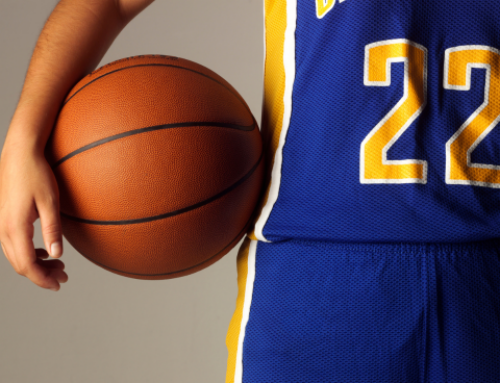Why Marques Colston Chose a Small School Over Playing in The Big 12 (And What You Can Learn From It)
Shortly before National Signing Day in 2001, Marques Colston had a decision to make.
An All-Conference receiver at Susquehanna Township High School in Harrisburg, Pennsylvania, Colston had shown enough promise that two college programs deemed him worthy of a scholarship offer.
One of them was the University of Missouri, which plays its home games in a 70,000-seat stadium and was a member of the prestigious Big 12 Conference at the time. The other was Hofstra University, a little-known 1-AA program that plays its games in a 15,000-seat stadium.
Seems like a simple decision, right? Maybe not. Colston elected to go to Hofstra, where he was a four-year letterman and a three-year starter. He finished his career at Hofstra with 182 receptions for 2,834 receiving yards and 18 touchdowns. He was subsequently selected in the seventh round of the 2006 NFL Draft by the New Orleans Saints and went on to become the franchise’s all-time leader in every major receiving category.
RELATED: 8 Star Athletes Who Had To Walk on Their College Teams
It’s safe to say Colston’s decision worked out well for him, but why did he choose little-known Hofstra over the bright lights of the Big 12? STACK recently caught up with Colston and learned his reasoning behind the decision. It can serve as helpful advice to any athlete who is or will be going through the recruiting process.
“I wasn’t a super productive high school player, so therefore I didn’t get recruited by a ton of schools. I only had two offers—one from Hofstra, one from the University of Missouri,” Colston said. “Missouri kinda came into the fold late, and I had already taken my visit to Hofstra and had seen what the coaches and players ahead of me had to offer. I knew I wanted to have an opportunity to play [right away].
“Hofstra was my best opportunity to develop at my own pace and play sooner rather than later. Going to Missouri, Big 12 at the time, possibly redshirting and sitting and maybe getting a chance to play my junior or senior year. So I chose Hofstra and it worked out for me. The perceived biggest opportunity isn’t always the biggest opportunity at the end of the day. I think in the recruiting process, a lot of people get tied up in the big-name schools and being able to select that hat on commitment day. But it’s more about understanding where you’re at and where you want to go.”
Would Colston’s decision to attend the University of Missouri have drawn more fanfare? Almost certainly. But he was thinking big picture, and he kne w that Hofstra was a better fit for him and his goals. Another important lesson Colston learned during his recruiting process was to be patient and continue to work even if the offers aren’t pouring in. He said, “[It’s about] really putting in the work and really grinding it out and putting yourself in position to be noticed. But at the same time, you gotta wait your turn sometimes. I’m a guy who wasn’t a five-star recruit, didn’t go to a 1-A school, no SEC or ACC. What that tells me is that everyone kinda develops at their own pace.”
READ MORE:
RECOMMENDED FOR YOU
MOST POPULAR
Why Marques Colston Chose a Small School Over Playing in The Big 12 (And What You Can Learn From It)
Shortly before National Signing Day in 2001, Marques Colston had a decision to make.
An All-Conference receiver at Susquehanna Township High School in Harrisburg, Pennsylvania, Colston had shown enough promise that two college programs deemed him worthy of a scholarship offer.
One of them was the University of Missouri, which plays its home games in a 70,000-seat stadium and was a member of the prestigious Big 12 Conference at the time. The other was Hofstra University, a little-known 1-AA program that plays its games in a 15,000-seat stadium.
Seems like a simple decision, right? Maybe not. Colston elected to go to Hofstra, where he was a four-year letterman and a three-year starter. He finished his career at Hofstra with 182 receptions for 2,834 receiving yards and 18 touchdowns. He was subsequently selected in the seventh round of the 2006 NFL Draft by the New Orleans Saints and went on to become the franchise’s all-time leader in every major receiving category.
RELATED: 8 Star Athletes Who Had To Walk on Their College Teams
It’s safe to say Colston’s decision worked out well for him, but why did he choose little-known Hofstra over the bright lights of the Big 12? STACK recently caught up with Colston and learned his reasoning behind the decision. It can serve as helpful advice to any athlete who is or will be going through the recruiting process.
“I wasn’t a super productive high school player, so therefore I didn’t get recruited by a ton of schools. I only had two offers—one from Hofstra, one from the University of Missouri,” Colston said. “Missouri kinda came into the fold late, and I had already taken my visit to Hofstra and had seen what the coaches and players ahead of me had to offer. I knew I wanted to have an opportunity to play [right away].
“Hofstra was my best opportunity to develop at my own pace and play sooner rather than later. Going to Missouri, Big 12 at the time, possibly redshirting and sitting and maybe getting a chance to play my junior or senior year. So I chose Hofstra and it worked out for me. The perceived biggest opportunity isn’t always the biggest opportunity at the end of the day. I think in the recruiting process, a lot of people get tied up in the big-name schools and being able to select that hat on commitment day. But it’s more about understanding where you’re at and where you want to go.”
Would Colston’s decision to attend the University of Missouri have drawn more fanfare? Almost certainly. But he was thinking big picture, and he kne w that Hofstra was a better fit for him and his goals. Another important lesson Colston learned during his recruiting process was to be patient and continue to work even if the offers aren’t pouring in. He said, “[It’s about] really putting in the work and really grinding it out and putting yourself in position to be noticed. But at the same time, you gotta wait your turn sometimes. I’m a guy who wasn’t a five-star recruit, didn’t go to a 1-A school, no SEC or ACC. What that tells me is that everyone kinda develops at their own pace.”
READ MORE:
RECOMMENDED FOR YOU
Create A Free Recruiting Profile Today!
CaptainU helps athletes & parents not only be proactive but also to manage and take control of their entire recruiting journey.












